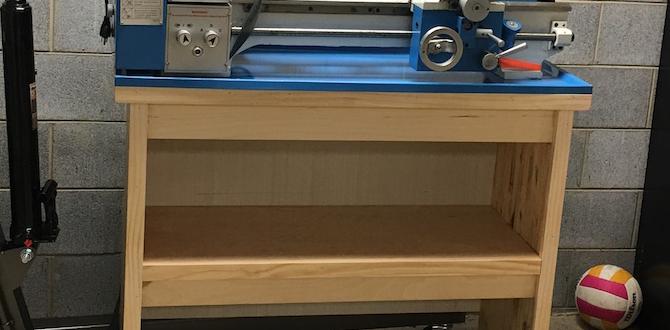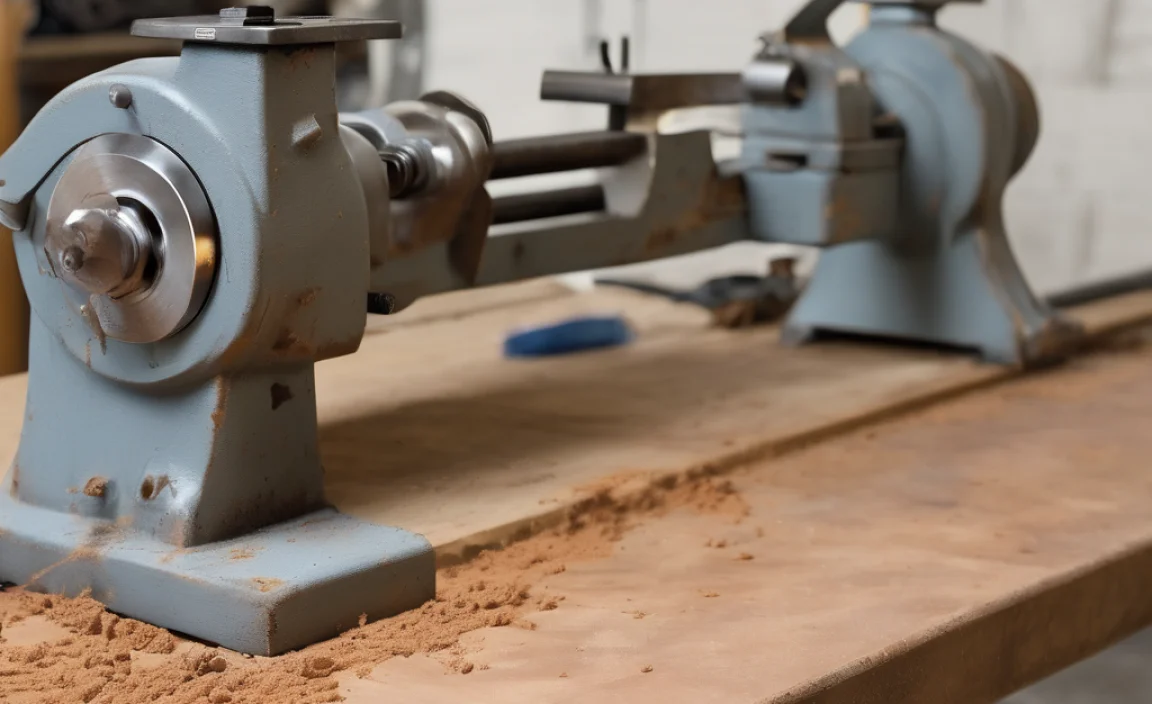Quick Summary: A 1/8 inch carbide end mill, especially one with a 6mm shank and designed for fiberglass, is essential for clean, precise cuts. It minimizes chipping and heat buildup, leading to better results and longer tool life.
Working with fiberglass can be a rewarding experience, but it often presents challenges for DIYers and machinists alike. One of the trickiest parts is achieving clean, precise cuts without causing excessive fraying or damage to the material. If you’ve ever struggled with your cuts looking rough or your tools wearing out too quickly, you’re not alone! The good news is, there’s a simple, effective solution that can transform your fiberglass projects. Today, we’re diving into why a specific tool, the 1/8 inch carbide end mill, is an absolute game-changer for anyone working with fiberglass. Get ready to discover how this small but mighty tool can make a big difference in your workshop.
Why Fiberglass is Tricky to Cut
Before we get to the solution, let’s quickly touch on why fiberglass can be such a pain to cut. Fiberglass is essentially woven glass fibers saturated with a resin. When you try to cut it with the wrong tool, it behaves in a few frustrating ways:
- Fraying and Delamination: The glass fibers can snag and fray, leading to rough edges and a messy appearance. In some cases, the layers of fiberglass can even separate, a process known as delamination.
- Heat Buildup: Friction from cutting generates heat. Fiberglass doesn’t handle heat well; it can soften the resin, clog your cutting tool, and even create toxic fumes.
- Abrasiveness: Glass fibers are inherently abrasive. This means they can quickly wear down softer cutting tools, rendering them dull and ineffective in no time at all.
These issues can lead to wasted material, subpar finished products, and a lot of frustration. That’s where the right tool comes in.
The Hero of the Hour: The 1/8 Inch Carbide End Mill
When it comes to cutting fiberglass, the 1/8 inch carbide end mill emerges as a true hero. But what makes it so special? Let’s break it down:
What Exactly is an End Mill?
An end mill is a type of milling cutter. Unlike a drill bit that primarily cuts downwards, an end mill can cut sideways as well as downwards. This makes it incredibly versatile for creating slots, pockets, profiles, and generally shaping materials. They have flutes (the spiraled grooves) that help clear away material as they cut.
What Makes it “Carbide”?
The “carbide” in carbide end mill refers to the material it’s made from: tungsten carbide. This is an extremely hard and durable material, much harder than steel. This hardness is key to its effectiveness on abrasive materials like fiberglass.
Why 1/8 Inch?
The 1/8 inch (approximately 3.175mm) size is a very common and useful diameter for many tasks. It’s small enough to allow for intricate detail work and precise cuts, but substantial enough to handle moderate material removal. For many fiberglass projects, it hits that sweet spot between maneuverability and efficiency.
The “Essential” Features for Fiberglass
While any carbide end mill is better than a non-carbide one for fiberglass, certain features make a significant difference:
- Single Flute Design: For softer, fibrous materials like fiberglass and plastics, single-flute end mills are often preferred. They provide more space in the flute to efficiently evacuate chips, reducing the risk of clogging and overheating. Less clogging means cleaner cuts and less stress on your machine.
- Specialized Coatings: Some end mills come with coatings (like TiN, TiCN, or ZrN) that further enhance hardness, reduce friction, and improve chip evacuation. While not strictly essential for basic work, they can extend tool life and improve cut quality on tougher jobs.
- “Up-Cut” vs. “Down-Cut” vs. “Compression”: This refers to how the flutes are designed to move chips.
- Up-cut flutes pull chips upwards, away from the workpiece. This is good for clearing material but can sometimes lift the edges of thin materials.
- Down-cut flutes push chips downwards, resulting in a cleaner top surface but potentially packing chips into the cut.
- Compression bits have a combination of up-cut and down-cut flutes. They are excellent for creating a perfectly clean edge on both the top and bottom of sheet materials, but they generate more heat and require more power. For fiberglass, a single-flute up-cut is often excellent to start with, as it clears material well.
- Extra-Long Shank (like 6mm shank): When you see “carbide end mill 1/8 inch 6mm shank extra long for fiberglass,” it’s highlighting a few important points. The 6mm shank is a standard size that fits many common routers and CNC machines. An “extra long” shank simply means the shaft of the end mill extends further from the collet or chuck. This is beneficial for reaching deeper into workpieces or for setups where you need to achieve a certain depth of cut. Proper length ensures you don’t bottom out your tool holder.
- Low Runout: Runout refers to the amount of wobble a cutting tool has when it spins. Low runout is crucial for precision. It means the tool spins predictably and accurately, leading to cleaner cuts and less vibration. For fiberglass, low runout helps prevent chipping and ensures smooth edges.
Technical Specifications: What to Look For
When you’re shopping for the right end mill, you’ll encounter a lot of technical terms. Here’s a quick breakdown of what’s important for successfully milling fiberglass:
| Feature | Importance for Fiberglass | What to Look For |
|---|---|---|
| Material | High hardness and heat resistance are critical to overcome the abrasive nature of glass fibers and prevent melting the resin. | Tungsten Carbide (Solid Carbide) |
| Flute Count | Fewer flutes allow for better chip evacuation, reducing clogging and heat buildup. This is vital for composite materials. | 1 or 2 flutes are generally best. |
| Shank Diameter | Must match your collet or chuck size. 6mm and 1/4 inch (6.35mm) are very common. | Ensure compatibility with your tool holder. |
| Cutting Diameter | 1/8 inch (3.175mm) is ideal for detail and general routing. Larger sizes can be used for faster material removal but may be less precise. | 1/8 inch for most applications. |
| Coating | Optional, but can improve performance, tool life, and surface finish by reducing friction and increasing hardness. | Uncoated is fine, but coatings like AlTiN or ZrN can be beneficial. |
| Helix Angle | A higher helix angle (e.g., 30-45 degrees) can help with smoother cutting and chip evacuation. | Moderate to high helix angles are generally good. |
| Length of Cut | Consider how deep you need to cut. Extra-long shanks offer more reach. | Standard or extended, depending on your project needs. |
How to Use Your 1/8 Inch Carbide End Mill Safely and Effectively
Using the right tool is only half the battle. Proper technique is essential for safety, getting the best results, and making your tool last. Here’s a step-by-step guide:
Step 1: Preparation is Key
- Wear Safety Gear: This is non-negotiable! Fiberglass dust is hazardous. Always wear safety glasses or a face shield, a dust mask (rated for fine particles), and gloves. Long sleeves are also a good idea.
- Secure Your Workpiece: Make sure your fiberglass is firmly clamped down. Any movement during cutting can lead to inaccurate results or dangerous tool slippage.
- Clean the Material: Ensure the surface of the fiberglass you’re cutting is free of dust, debris, or any contaminants.
- Check Your Tool: Inspect your end mill for any signs of damage or dullness. A damaged tool is a safety hazard and will produce poor results.
Step 2: Setting Up Your Tool and Machine
- Insert the End Mill: Carefully insert the end mill into the collet or chuck of your router or CNC machine. Ensure it’s seated properly for its full depth to minimize runout. Tighten securely.
- Set the Spindle Speed (RPM): Fiberglass can be milled at a moderate to high speed. For a 1/8 inch carbide end mill, a starting point of 18,000 to 24,000 RPM is often recommended. The exact speed can depend on your specific machine, the type of fiberglass, and the depth of cut. If you hear chattering or the tool seems to be struggling, you might need to adjust. A good resource for calculating spindle speeds for different materials and tools can be found on sites dedicated to machining best practices. For instance, many CNC suppliers offer calculators or guides that can help.
- Set the Feed Rate: The feed rate is how fast you move the tool through the material. Too fast, and you’ll stall the tool or break it. Too slow, and you’ll overheat and melt the material. For fiberglass, a moderate feed rate is usually best. This is often expressed in inches per minute (IPM) or millimeters per minute (MM/min). A good starting point might be between 10-30 IPM (250-750 mm/min) for handheld routing, and potentially faster for CNC, depending on depth of cut. It’s often better to take lighter passes more frequently than one deep pass.
- Depth of Cut: For a 1/8 inch end mill, avoid taking very deep cuts in one pass. For softer materials like fiberglass, it’s much better to take multiple shallow passes. For example, if you need to cut 1/4 inch deep, consider making two passes of 1/8 inch each, or even three passes of about 0.080 inches. This reduces the load on the tool, prevents overheating, and results in a cleaner cut.
Step 3: The Cutting Process
- Plunge Carefully: If you need to plunge the end mill straight down into the material, do so slowly. Some specialized end mills are designed for plunging, but for general-purpose ones, it’s best to be cautious.
- Maintain Consistent Feed: Once you start cutting, try to maintain a steady, consistent feed rate. Avoid stopping or slowing down mid-cut, as this can cause the tool to overheat and melt the material. The goal is to let the flutes do their work clearing material away.
- Clear Chips: As you cut, the flutes will remove material. It’s important to ensure these chips are being evacuated properly. If you see them building up or melting, slow down your feed rate or increase your spindle speed slightly, or consider using a vacuum dust collection system.
- Cooling (Optional but Recommended): For extensive cutting, preventing heat buildup is crucial. Some users employ a light air blast or a specialized cutting fluid designed for plastics and composites. Be cautious with liquids around electrical tools, and always ensure proper ventilation. A vacuum system not only collects dust but also provides some cooling airflow.
Step 4: Finishing Touches
- Clean Up: Once the cut is complete, carefully remove the workpiece. Use a shop vacuum to clean up fiberglass dust. Avoid sweeping, as it can aerosolize the dust.
- Inspect the Cut: Examine your edges. If they are clean and smooth, congratulations! If there’s still some minor fraying, you might need to refine your feed rate, spindle speed, or depth of cut for future projects. A light sanding with fine-grit sandpaper can often clean up any remaining imperfections.
Tips for Extending Tool Life and Improving Results
Your 1/8 inch carbide end mill is a valuable tool, and a little care goes a long way:
- Don’t Push It Too Hard: Forcing the tool through the material is the quickest way to break it or wear it out prematurely. Stick to sensible depths of cut and feed rates.
- Keep it Clean: Resin buildup on the flutes can reduce cutting efficiency and increase heat. Clean your end mill periodically with a suitable solvent (like acetone, but use with caution and good ventilation).
- Use the Right Machine: A sturdy router or CNC machine with good speed control is essential. Wobbly spindles or flimsy machines will lead to poor cuts and broken tools.
- Consider the Fiberglass Type: Different fiberglass resins and weaves will have slightly different cutting characteristics. A bit of experimentation might be needed to find the perfect settings for your specific material.
- Proper Storage: Store your end mills in a protective case to prevent them from getting damaged or dulling against other tools.
When is a 6mm Shank Better Than 1/4 Inch?
You might see end mills with 1/8 inch cutting diameter but either a 6mm shank or a 1/4 inch (0.250 inch) shank. Both are extremely common. The choice often comes down to the tools you own:
- 6mm Shank: Very common in European-made routers and many smaller CNC machines. If your collet is designed for 6mm bits, you’ll need a 6mm shank.
- 1/4 Inch Shank: Standard in many North American tools. If your collet is 1/4 inch, this is what you’ll need.
For a 1/8 inch cutting diameter, the difference in rigidity between a 6mm and a 1/4 inch shank is minimal. The key is to match the shank size to your machine’s collet. If you’re unsure, check your tool manual or measure your existing collets.
Potential Issues and How to Solve Them
Even with the right tool and setup, you might encounter a few hiccups:
- Melting/Gooey Cuts: This is usually caused by too much heat. Try:
- Increasing your feed rate slightly.
- Decreasing your depth of cut.
- Ensuring better chip evacuation (check flute clearance).
- Using a slight air blast for cooling.
- Chipping/Frays Edges: This often means the tool is dull, you’re feeding too slowly, or the material is lifting. Try:
- Ensuring your end mill is sharp.
- Increasing your feed rate.
- Decreasing your depth of cut.
- For handheld routing: Consider using a tape on the edge of the material or a down-cut bit (if available and appropriate) to help hold the edge.
- For CNC: Ensure your workpiece is held down securely to prevent any vibration or lifting.
- Tool Breakage: This is scary and expensive! It’s usually due to:
- Taking too deep a cut.
- Feeding too slowly (letting the tool rub instead of cut).
- Hitting a knot or an inconsistency in the material.
- A tool that’s already damaged or dulled.
- An improperly seated tool in the collet.
Always err on the side of caution with shallower cuts and moderate feed rates.
Comparing Carbide End Mills to Other Tools for Fiberglass
Let’s quickly look at why carbide end mills are superior to other common cutting tools for fiberglass:
| Tool Type | Pros for Fiberglass | Cons for Fiberglass | Why Carbide End Mill is Better |
|---|---|---|---|
| Standard Steel End Mill | Widely available, relatively inexpensive. | Dulls very quickly due to abrasiveness, generates excessive heat, leads to poor cut quality (melting, fraying). | Much harder and more heat-resistant, leading to cleaner cuts and longer tool life. |
| HSS (High-Speed Steel) End Mill | Better heat resistance than standard steel. | Still dulls much faster than carbide on fiberglass, can still melt the material. | Carbide is significantly harder and maintains its edge longer against glass fibers. |
| Router Bits (General Purpose) | Can cut fiberglass. | Many are not optimized for composites, can still cause fraying, significant heat. | Carbide end mills, especially those designed for composites or with single-flute designs, offer superior precision and chip evacuation for fiberglass. |
| Diamond Grit Bits
|





